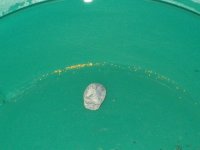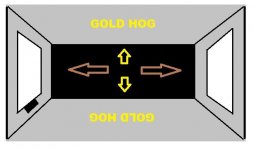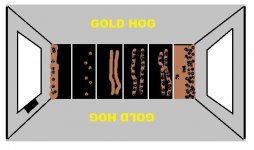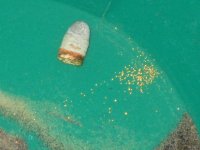Capt Nemo
Bronze Member
I finally tried my Flow Pan with beach sand. I ran with concentrate that had just the blond and garnet removed but intact gold. I was hitting a average of 2 pieces per scoop with the Garrett 10". I was panning in a 6-7 gal mixing tub. The scoop used is the red handled one found in the Lowe's garden area. (1 scoop = 10" pan full)
I started by adding a total of 3 scoops to the Flow Pan. When I submerged the pan, the sand immediately slumped and filled the pan to a depth perfect for panning. I began using a steering wheel motion to stratify the pan. A circle about 3" in diameter formed in the center of the pan, and did not stratify. I then started a jerky front to back rocking motion, which made the circle stratify, and then a side to side motion which also kept the center stratified. I kept stratifying for about 15 seconds using a combination of the three motions, before washing out the pan. I washed out by letting the pan fill with water, and lifting the front of the pan upward. It was slower than I'd like, but then I had no current in the mixing tub to provide crossflow for the pan. I did get more aggressive towards the end of the washout. I then preformed a full cleanout and panned the result. The result was 8 pieces from #150 to #200 in size. From what I was seeing before with the Garrett, she's not loosing anything. It was still faster than using the Garrett.
So the Flow Pan CAN run Lake Superior beach sand!
When working sand, watch the contents carefully to make sure they stratify. Do not use just one stratification method. Take 10-15 seconds of stratification time. 3 scoops are the perfect amount of sand. A squirt bottle is useful for cleanouts. A 7 gal mix tub does not work well for this pan (water everywhere!).
I do wish that Doc will come out with a narrower version that could fit in a 5-6 gallon bucket of water for faster cleanouts. The Flow Pan is about 1" too wide.
I started by adding a total of 3 scoops to the Flow Pan. When I submerged the pan, the sand immediately slumped and filled the pan to a depth perfect for panning. I began using a steering wheel motion to stratify the pan. A circle about 3" in diameter formed in the center of the pan, and did not stratify. I then started a jerky front to back rocking motion, which made the circle stratify, and then a side to side motion which also kept the center stratified. I kept stratifying for about 15 seconds using a combination of the three motions, before washing out the pan. I washed out by letting the pan fill with water, and lifting the front of the pan upward. It was slower than I'd like, but then I had no current in the mixing tub to provide crossflow for the pan. I did get more aggressive towards the end of the washout. I then preformed a full cleanout and panned the result. The result was 8 pieces from #150 to #200 in size. From what I was seeing before with the Garrett, she's not loosing anything. It was still faster than using the Garrett.
So the Flow Pan CAN run Lake Superior beach sand!
When working sand, watch the contents carefully to make sure they stratify. Do not use just one stratification method. Take 10-15 seconds of stratification time. 3 scoops are the perfect amount of sand. A squirt bottle is useful for cleanouts. A 7 gal mix tub does not work well for this pan (water everywhere!).
I do wish that Doc will come out with a narrower version that could fit in a 5-6 gallon bucket of water for faster cleanouts. The Flow Pan is about 1" too wide.
Last edited:
Upvote
0











